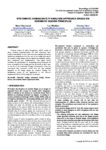
|
Systematic Human-Safety Analysis Approach Based on Axiomatic Design Principles
Ghemraoui, Rima, Luc Mathieu, and Nicolas Tricot
5th International Conference on Axiomatic Design, 2009
Current means of safety integration, which consist in safety barriers implementation for risk reduction, have reached their limits. In fact, risk reduction analysis and safety barriers are implemented in the end of the design process, in the detailed design phase, and are rapidly increasing in variety, size, complexity and sophistication. This paper firstly, describes the problematic of integrating safety indicators as soon as possible in the design process. Secondly, a brief state of the art of the Axiomatic Design is introduced. Then, the conceptual risk reduction model and the risk analysis approach in all design stages are detailed. Finally, the preliminary results of the application to the Tractor- Implements Hitch (TIH) design are developed.
|

|
Reducing the Time Dependent Complexity in Organizational Systems Using the Concept of Functional Periodicity
Matt, Dominik T.
5th International Conference on Axiomatic Design, 2009
Economic growth and sustainable value creation are a company’s most important long-term targets. However, practical experience shows that large structures notoriously suffer from efficiency losses due to increasing organizational complexity and bureaucracy. To realize a profitable growth, companies have to be good in handling their internal diseconomies caused by the increased complexity of large organizations [Matt, 2007/b]. This hypothesis is confirmed by a study of the St. Gallen Centre of Organizational Excellence (CORE) in which 300 large European enterprises were analyzed within a period of 10 years [Gomez et al., 2007]. The results of the research show: the central challenge for profitable growth consists in a company’s ability to continuously improve its organization in efficiency and flexibility. Thus, one of the major challenges is to select an organizational system configuration that promotes a sustainable business growth and is easy to operate and manage. In this paper a concept for reducing the complexity of an organizational system is discussed in order to maintain a company’s high system efficiency as a success factor for sustainable growth.
|
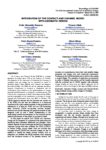
|
Integration of the Contact and Channel Model with Axiomatic Design
Marques, Pedro Alexandre, Pedro Manuel Saraiva, Jose Gomes Requeijo, Thomas Alink, Albert Albers, and Francisco Frazao Guerreiro
5th International Conference on Axiomatic Design, 2009
The Contact and Channel Model (C&CM) is a design approach developed since 1999 at the Institute of Product Development of the University of Karlsruhe, in Germany. It considers that any design can be described in terms of Working Surface Pairs (WSPs) and Channel and Support Structures (CSSs). The WSPs are all the pair-wise interfaces between components, or between a component and its environment, that contribute to the transformation of energy, material and information occurring in a technical system. The CSSs are the components or fields connecting only two WSPs, and are responsible for the transference or storage of energy, material and information from one WSP to another. The C&CM approach assumes that the functions are carried out by the WSPs, but also that the fulfillment of a functional requirement for a given system depends on the properties and interactions of at least two WSPs and one CSS connecting them. Moreover, C&CM incorporates concrete heuristic solutions and specific drawings and graphical symbols to help designers come up with a better understanding of the relationships between the description of the functions and the physical embodiment of the system, at any level of detail. In this paper we analyze how C&CM and Axiomatic Design can be integrated, by comparing both approaches and identifying their similarities, differences and synergies.
|

|
From Customer Needs to Design Parameters: Description of a Knowledge Based and Functionnal CAD Model
Bluntzer, Jean-Bernard, and Samuel Gomes
5th International Conference on Axiomatic Design, 2009
Since the last decade, considering the globalization process of the economy, the market evolution has tended to reduce product costs and to decrease time devoted to the product design and development. In this context, it is also important to consider the growing need for improving product performance and for integrating user specifications very early in the design process. In order to answer these needs, this paper proposes a specific design method based on Axiomatic Design methodology and a functional analysis in order to reduce the time dedicated to routine engineering. This method is directly integrated into our self-developed PLM system – Product Lifecycle Management- in order to work in a worldwide and collaborative design environment.
|
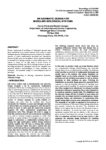
|
An Axiomatic Design for Modeling Biological Systems
Pirim, Harun, and Burak Eksioglu
5th International Conference on Axiomatic Design, 2009
Precise mathematical modeling of biological systems may allow researchers to accurately estimate future states of these biological systems. Biological systems are regarded as complex systems to which mathematical modeling and Operations Research (OR) tools can be applied. Also, a general roadmap is essential for a biology scientist to decide which part of the system to focus on. In this study a recent review of computational biology and OR in biology literature is given. Modeling problems in biological sciences are classified and potential solution methodologies to these problems are addressed. An axiomatic design of a modeling procedure is provided.
|
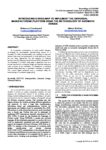
|
Introducing a Road-Map to Implement the Universal Manufacturing Platform Using the Methodology of Axiomatic Design
Houshmand, Mahmoud, and Alireza Mokhtar
5th International Conference on Axiomatic Design, 2009
In competitive environment of quick market changes, developing an interoperable manufacturing system is a necessity. To realize interoperability, the exchange of part and product data must be independent of their platforms. There are two basic approaches for this purpose: i) Utilizing interface and ii) Utilizing neutral formats. STEP (Standard for the Exchange of Product data) plays a significant role as a neutral data model to integrate design and manufacturing and other activities in an enterprise. To implement a universal manufacturing platform, a systematic roadmap is required. The current paper proposes such a roadmap using the methodology of axiomatic design (AD).
|

|
Emergence of Coupled and Complex Failures in Mature Japanese Industries
Nakao, Masayuki, Kensuke Tsuchiya, and Kenji Iino
5th International Conference on Axiomatic Design, 2009
The designer’s mind process of the engineering failures was analyzed from the Axiomatic Design perspective using the failure databases of Japanese industries. Besides the simple failures like careless operator’s mistakes, we also found a lot of the coupled and complex failures like computer system down due to excess internet purchasing accesses. The notice of the troubles is beyond the designer’s assumptions in planning. The simple failures are decreasing because Japanese industries become so mature that the job procedures are perfectly set up. But the complex failures are emerging because the systems become complicated nowadays. As a countermeasure, making a module with some coupled FRs is inexpensive and effective, visualizing and decoupling the failed design.
|

|
Decoupling (Un)loading Operations from the Land-Sea Interface in Port Service: The Mobile Floating Port Concept
Morrison, James R., and Taesik Lee
5th International Conference on Axiomatic Design, 2009
To address the problem of increasing demand for port service capacity worldwide, subject to the constraint that existing ship structure and load/unload methodologies must be essentially maintained, we pursue the system-level design of port services based on axiomatic design. We show that the traditional approaches to increase capacity (e.g., faster cranes and increased berths) do not address the fundamental coupling between the functional requirements (FRs) to load/unload containers and port the containers across the land-sea interface. We next demonstrate that a mobile floating port (MFP) concept is a design that decouples these FRs. Further, by considering the MFP as an agile service asset with the flexibility to provide port services to multiple port locations, one can decouple the service from dependence upon a specific port.
|
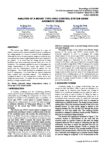
|
Analysis of a Mount Type HVAC Control System Using Axiomatic Design
Lee, Se-Jung, Eul-Pyo Hong, and Gyung-Jin Park
5th International Conference on Axiomatic Design, 2009
The mount type HVAC control system is a type of HVAC control system which is installed between a ceiling and the ceiling boards of a room to control room temperature. Although the device is quite popular, design is conducted by a conventional way where engineering intuition and experiences are utilized. It is found that the design process is fairly inefficient and time-consuming because there are a lot of feedbacks. The axiomatic approach is used to investigate the design characteristics of the mount type HVAC control system and the Independence Axiom is utilized for the investigation. The overall hierarchy is established up to the level of components. It is found that the current design has many coupled and redundant aspects. The hierarchy is reorganized based on the Independence Axiom and a new design process is found. To exploit the new design process in practice, a design manual is made.
|
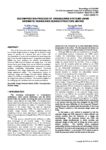
|
Decomposition Process of Engineering Systems Using Axiomatic Design and Design Structure Matrix
Hong, Eul-Pyo, and Gyung-Jin Park
5th International Conference on Axiomatic Design, 2009
One of the most active areas of engineering design today is a modular design method to design and to produce a large variety of product in a limited time and a lower cost. Decomposition of system into modules is the most important part of the modular design method. Design Structure Matrix (DSM) has been proposed for efficient modularization. However, DSM does not indicate the design flow. It is well known that a good design flow can be defined by axiomatic design. In this paper, a rational method is presented to define modules considering relationships between functional requirements and design parameters and interactions of design parameters within. The Independence Axiom of Axiomatic design and Design Structure Matrix (DSM) are utilized for efficient modularization of a design system and the design flow without feedbacks. The method is applied to the ceiling type air conditioner and the results are analyzed.
|
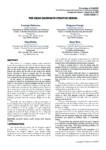
|
The Ideas Diagram in Creative Design
Slatineanu, Laurentiu, Oana Dodun, Margarete Coteata, and Alexei Toca
5th International Conference on Axiomatic Design, 2009
The activity of a designer engineer could sometimes involve the necessity to come with a certain solution in a short time; in such a situation, the engineer will not allocation much time to the design activity and will use the routine design instead; this means that he will use the solutions he already knows. However if there is enough time for the design activity, the engineer will use the creative design, trying to find new solutions to solve the design problem.
|
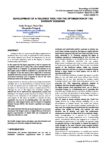
|
Development of a Tailored Tool for the Optimization of the Surgery Sessions
Bottacci, Daria, Paolo Citti, Alessandro Giorgetti, and Ferruccio Dubini
5th International Conference on Axiomatic Design, 2009
During the last few years many Six Sigma applications in Healthcare have been made, in particular in North America. The results obtained have shown the importance of the use of a structured approach, such as Six Sigma, to increase hospital quality performance. In this paper the Six Sigma approach is used to improve the occupation index and to reduce the costs connected with the surgery block of a hospital. In particular the attention is on the surgery session which is composed of a planned case mix of surgeries. In fact the session uses a high level of resources (temporal resources, human resources, material resources and economical resources) and it appears as one of the most critical processes in the hospital system.
|
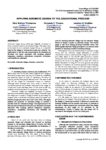
|
Applying Axiomatic Design to the Educational Process
Thompson, Mary Kathryn, Benjamin C. Thomas, and Jonathan B. Hopkins
5th International Conference on Axiomatic Design, 2009
Axiomatic design theory (AD) was originally developed to form a scientific basis for mechanical design. This paper takes an in-depth look at axiomatic design theory as a scientific basis for the design of educational courses and curricula. The implications of the first and second axioms for education are discussed and issues associated with coupling, physical integration, repetition, redundancy, complexity, robustness, and flexibility are addressed.
|
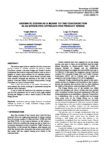
|
Axiomatic Design as a Means to Find Contradiction in an Integrated Approach for Product Design
Rizzuti, Sergio, Francescantonio Giampa, Luigi De Napoli, and Francesco Lofranco
5th International Conference on Axiomatic Design, 2009
The present paper aims to underline the strict connection among a series of valuable methods for product design: Functional Analysis, Axiomatic Design and Quality Function Deployment, that must be employed jointly in order to allow a designer to reach a good solution for an industrial product. These methods, that share the matrix format common basis, must mutually exchange the elements at the basis of each method: Customer Needs, Functional Requirements, Design Parameters, in a sort of virtuous circle.
|

|
The Minimum Constraint Design and the First Axiom
Santos, Antonio Gabriel, Arlindo Silva, and Antonio Goncalves-Coelho
5th International Conference on Axiomatic Design, 2009
Minimum Constraint Design (MinCD) is a design approach for mechanical systems yielding to the required performance with a minimum number of external constraints at each one of the system’s components. The method is claimed to be appropriate for the design of mechanical systems, allowing for assembling with zero looseness and binding, zero distortion and no residual stress. Such designs can be implemented with simple machining, loose manufacturing tolerances and semiskilled labour for both assembling and disassembling. As a result, MinCD allows for cost decreasing in both design and manufacturing, and to a noteworthy increasing in reliability and maintainability.
|
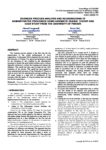
|
Business Process Analysis and Reengineering of Administrative Processes using Axiomatic Design: Theory and Case Study from the University of Firenze
Campatelli, Gianni, and Paolo Citti
5th International Conference on Axiomatic Design, 2009
The business process analysis is the first step for the improvement of the overall performances of every organization. In this paper will be presented the case study of the University of Firenze. Our group has developed a model for the evaluation of the coupling for the administrative processes to identify the most critical activities and to evaluate alternative solutions to reduce the coupling and increase the efficiency. This model has been used as basis for the ABC evaluation of the process. This model has been applied to some administrative processes of the University of Firenze in order to prove how the administrative process coupling, in a AD sense, brings to a high level of inefficiency of the processes with the results of long processing time and high cost for the organization.
|
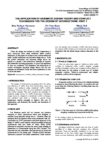
|
The application of Axiomatic Design Theory and Conflict Techniques for the Design of Intersections: Part 1
Thompson, Mary Kathryn, Oh Hoon Kwon, and Min Ju Park
5th International Conference on Axiomatic Design, 2009
Today the design and analysis of traffic intersections is most commonly done using traditional traffic conflict techniques. In this paper, we compare and combine traditional traffic conflict techniques and axiomatic design theory. Both the conflict techniques and axiomatic design theory are applied to a generic 4-way intersection. Strategies to improve the intersection including separation of space and separation of time are considered. The limitations and implications of conflict techniques, axiomatic design theory, and the two strategies are discussed.
|
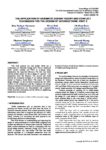
|
The application of Axiomatic Design Theory and Conflict Techniques for the Design of Intersections: Part 2
Thompson, Mary Kathryn, Min Ju Park, Oh Hoon Kwon, Eleonora Ibragimova, Hansun Lee, Sunwook Myung
5th International Conference on Axiomatic Design, 2009
This work presents two case studies which use a combination of Axiomatic Design (AD) Theory, traditional traffic conflict analysis, and TRIZ to re-design urban intersections for improved efficiency. The first case study involves several options for the re-design of a generic 4-way intersection from the literature. The second case study involves the conceptual redesign of an existing intersection located in Daejeon, South Korea. The impact of various design strategies on the functional requirements, the traffic conflicts in the intersection, and the coupling in the design matrix are examined. Both holistic and modular approaches to modelling intersections are demonstrated and compared. Finally, symmetry, redundancy, and the effects of neighboring intersections are discussed.
|
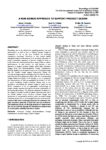
|
A New AD/MDO Approach to Support Product Design
Ferreira, Irene, Jose A. Cabral, and Pedro M. Saraiva
5th International Conference on Axiomatic Design, 2009
Nowadays, due to its critical role regarding product cost and performance, as well as time to market, product design is considered to be at the new frontiers for achieving competitive advantage. Therefore, to face today’s rapidly changing business environments, it is extremely important to adopt a systematic approach to product design, in order to avoid errors and consequently achieve shorter time-to market performances. In this context, we will describe a new approach to support product design, which links Axiomatic Design (AD) and Multidisciplinary Design Optimization (MDO), applied in an integrated way at the conceptual design and the detailed design stages, respectively.
|
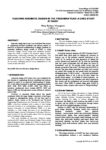
|
Teaching Axiomatic Design in the Freshman Year: A Case Study at KAIST
Thompson, Mary Kathryn
5th International Conference on Axiomatic Design, 2009
Axiomatic design theory was once considered the domain of engineering doctoral candidates and industry experts in search of an improved understanding of design. However, an innovative freshman design course at KAIST is using Axiomatic Design Theory, along with traditional product design and TRIZ, to improve the students’ ability to think independently, consciously, rationally, and synthetically. This paper discusses the basic format, goals, and philosophy for ED100: Introduction to Design and Communication. Finally, the successes, challenges, and the future implications of the course are also discussed.
|
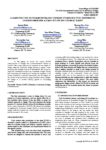
|
Learning the Fundamentals of Design Through the Axiomatic Design Process: A Case Study on ED100 at KAIST
Park, Aaron, Seung Jae Lee, Soo-Han Chung, Byung-Gyu Lee, and Jung Kim
5th International Conference on Axiomatic Design, 2009
In this paper, we review the course ED100 “Introduction to Design and Communication” offered at KAIST. This course instructs the students on the basics of design using the Axiomatic design process, a unique course structure, and multiple sources of information. We review indepth the correlation between the Axiomatic Design Theory and curriculum, the behaviour of students in response to the course material in a semester framework, and the impact of the course on the students by using our project as an example: the design of a vaccine delivery system to developing countries.
|

|
The Application of Axiomatic Design Theory on a Cell Phone Interface for Location-Based Bus Application
Park, Jin-a, Hyo-na Lee, Kyung-ae Ha, Yong-jun Hwang, and Alice Oh
5th International Conference on Axiomatic Design, 2009
This paper presents our design for a user interface for mobile phone applications that enable location-based realtime transportation information such as bus routes and schedules. We solve three important user interface issues– inefficient structure, limited information, unsatisfactory visualization. Our program provides shortcuts to help switch to other parts easily. We change the display method from table view to graphical view. In addition, our program provides detailed information such as the number of transfers and location of bus stops.
|

|
Lessons Learned by Applying Axiomatic Design to an Emergency Department
Peck, Jordan S., Erik M. W. Kolb, Taesik Lee, and Sang-Gook Kim
5th International Conference on Axiomatic Design, 2009
Without a doubt, a hospital’s Emergency Department (ED) is a complex system. The operations of an ED are complicated by a mix of Technology (testing equipment, electronic medical record, computer services, treatment devices, etc.), human issues (staff needs and interactions, patient needs and interaction, and interactions between staff and patients), politics (issues of health insurance, laws governing health treatment, privacy issues, hospital management, etc.), and many more factors. This complexity not only makes ED operations difficult, but also communicating an issue both inside and outside of the ED can become difficult without a common understanding of the forces at work. This paper uses the Emergency Department Design Decomposition (ED3), an Axiomatic Design of an Emergency Department, to identify, understand, and communicate problems in an ED. We begin by summarizing the ED3. Then the ED3 is used to identify the inherent functional couplings in the design of an ED system. Next we analyze the couplings and judge how the complications the couplings suggest are equivalent to our findings in a case study performed at a suburban community hospital in Massachusetts.
|
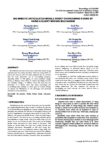
|
Bio-Mimetic Articulated Mobile Robot Overcoming Stairs by Using a Slinky Moving Mechanism
Jeon, Byung Soo, Yong Cheol Jeong, Kyung Woon Kwak, Su Ji Yeo, Da Young Ha, and Soo Hyun Kim
5th International Conference on Axiomatic Design, 2009
Bio-mimetic articulated robots are robots that imitate living creatures and have many modules. There are many kinds of robots and they are used for many purposes but we decided that the most important one is overcoming obstacles, especially stairs. In this paper, we used axiomatic design theory to improve these kinds of robots and finally decided one complete design – a “slinky” robot. We find that the prototype of a slinky robot has many advantages for overcoming stairs compare to other types of robots. Finally, we discuss the limitations of the prototype and potential solutions to these problems.
|
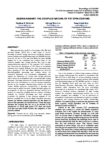
|
Design Against the Coupled Nature of PZT Spin Coating
Bathurst, Stephen, Hyung Woo Lee, and Sang-Gook Kim
5th International Conference on Axiomatic Design, 2009
Many groups have worked to incorporate thin film lead zirconate titanate (PZT) into a wide range of devices including: actuators, energy harvesters, resonators, pressure sensors, pumps, nano-positioning stages, and MEMS switches. However, the use of PZT has been limited in many MEMS designs due to the constraints and coupled nature of the currently popular spin coating process. Not only is spin coating inherently wasteful of the expensive PZT solution, but it prevents the deposition of PZT films on non-planar substrates and requires difficult, low yield, patterning steps. Direct printing of PZT thin films eliminates the need for photolithographic patterning and etching, allows for controlled deposition over non-planar topographies, and enables the fabrication of devices with varying thickness which cannot be accomplished with conventional spin coating processes. This paper presents the design interaction analysis that lead to the development of a dot on demand deposition process as the adequate manufacturing solution for small volume MEMS products. Furthermore, it describes the various ways in which Axiomatic Design principles guides the development of this new deposition process. Included is a method of resolving coupling between solution chemistry desirable for thermal processing and fluid properties acceptable for printing. It also presents analysis of the inherent coupling that occurs in digital deposition processes between the discrete material deposition and the desire for uniform film geometry and microstructure. Finally this paper discusses the coupling that has yet to be resolved in the manufacture of robust high quality PZT films and future work that may help further facilitate the integration of this powerful material.
|
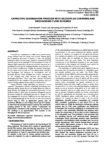
|
Capacitive Deionization Process with Decoupled Charging and Discharging Flow Schemes
Barman, Ishan, Taesik Lee, Gyunyoung Heo, and Nam P. Suh
5th International Conference on Axiomatic Design, 2009
Cost-effective desalination of saline water, which is more energy efficient than the widely used reverse osmosis (RO) and evaporation processes, is desired to solve the growing freshwater crisis. In recent years, capacitive deionization (CDI), which is based on the principle of electrosorption of ions on charged high surface-area electrodes, has been reported as a promising technology for desalting brackish water, because of its low power requirements. Despite its intrinsic advantages, the low water recovery ratio of CDI, limited plant efficiency and throughput has hindered its development into an industrial process. These problems are a direct consequence of the coupling that exists between the charging and discharging processes. There exist three primary functional requirements for the complete CDI process whereas only two top-level design parameters are utilized to address these. Using axiomatic design principles, we propose a novel capacitive deionization process employing permeating flow discharge (PFD), which adds a new design parameter (solvent drag) thereby decoupling the functional requirements. In the proposed scheme, waste water is permeated through the porous electrodes during the discharging process in contrast to the flow in-between the electrodes employed for the AFD process. The underlying principle is that the rate of removal of ions by solvent drag in PFD is significantly greater than by convection-diffusion in AFD. Using a bench-top CDI module, we show that the proposed solution removes the unavoidable coupling present in the AFD scheme. Furthermore we demonstrate a reduction in the discharge time by a factor of two resulting in an approximately 30% increase in the throughput of the CDI process.
|
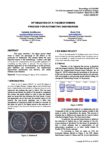
|
Optimization of a Thermoforming Process for Automotive Dashboards
Arcidiacono, Gabriele, and Paolo Citti
5th International Conference on Axiomatic Design, 2009
This paper describes a Six Sigma project which wants to reduce the percentage of the defects in the production of dashboards. The example shows the most important aspects of the methodology: it sheds a new light on the process comprehension and its possible application to everything we may define as process. The key issues are extensive application of the methodology to all the processes, great flexibility and customization, the improvement opportunities identification and selection, and results evaluation and validation.
|
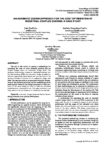
|
An Axiomatic Design Approach For the Cost Optimisation of Industrial Coupled Designs: a Case Study
Fradinho, Joao, Antonio Goncalves-Coelho, and Antonio Mourao
5th International Conference on Axiomatic Design, 2009
The aim of this work is to present a methodology for optimising the costs of some industrial products that are coupled designs based on Axiomatic Design (AD). The proposed methodology consists in combining Response Surface Methodology (RSM) and Axiomatic Design as applied to both the engineering characteristics and cost functions of the products through a common set of explanatory design variables. The response surfaces are generated during the development of the product’s prototype, and the methodology allows predicting the values for the design parameters of other products of the same family, in order to fulfil the functional requirements at a prescribed cost. The paper includes a case study related to the development of rubbercork raw material.
|
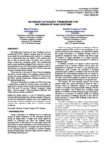
|
An Energy Efficiency Framework for the Design of HVAC Systems
Cavique, Miguel, and Antonio Goncalves-Coelho
5th International Conference on Axiomatic Design, 2009
The higher-level functions of heat, ventilation and airconditioning (HVAC) systems changed along the last forty years, simply from providing thermal comfort to a multipart set of requirements. Since the eighties, HVAC systems must also be able to provide indoor air quality and to recover energy. During the mentioned period, the manufacturing project teams somewhat redesigned those systems in order to accommodate the new FRs. This procedure disagrees with the fifth theorem of Axiomatic Design (AD), which in such cases requires a complete system redesign. The recent rise in the price of the oil barrel emphasizes the need to recover energy in any building, namely in HVAC systems. The energy regulations, ASHRAE 90.1 in the US and the EPBD (Energy Performance Building Directive) in the EU, address this problem. The aim of this paper is to analyse an HVAC system that is independent in terms of thermal comfort and indoor air quality, and to add the “reduce energy” functional requirement (FR). This new FR has four “children” functions: “adapt flows”, “recover energy”, “choose equipment efficiency” and “define efficient network conditions”.
|
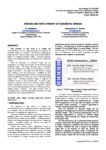
|
Design and Deployment of Axiomatic Design
Dickinson, Al, and Christopher A. Brown
5th International Conference on Axiomatic Design, 2009
The objective of this work is to further the understanding of how to design and institute the practice of axiomatic design at a company. This includes designing the design process. This work goes beyond previously published papers on teaching axiomatic design. Teaching axiomatic design is one thing; instituting it as a practice in a company is another. Both the institution of axiomatic design and the designing of the design process itself can be addressed using axiomatic design. The paper discusses how to formulate Functional Requirements (FRs) for providing an effective design environment. The upper level FRs include: manage value addition, costs and investments. Fulfilling the FRs requires developing appropriate metrics for engineering design work, including how to measure the value of progress during design work. Teaching axiomatic design to engineers is considered as part of the investment FR. In order to gain maximum corporate benefit from axiomatic design training, careful consideration must be given to deployment aspects such as pre-training preparation, effective training, and posttraining project coaching. The paper includes tips on coaching teams, as well as maintaining momentum in a large organization with competing initiatives.
|